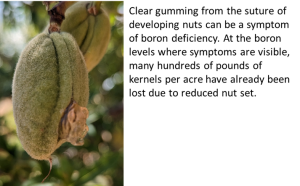Jaime Ott, UCCE Tehama, Shasta, Glenn, and Butte Counties
Almonds have a strange relationship with boron: it is required for effective pollination and to set a good crop but can quickly become toxic if there is too much in the soil or in irrigation water. With its effects on both yield and tree health, dialing in the boron levels in your orchard is well worth some attention.
The Bottom Line:
- Boron is a necessary nutrient which can be toxic at higher levels.
- Hull sampling at harvest is the only way to understand the boron status of your orchard.
- For many orchards, a fall foliar spray of boron will increase yields the following year by hundreds of pounds per acre.
Soil application of boron is the best long-term correction for low boron in an orchard, but this won’t increase yield the following year like a foliar spray.
Recommended Actions:

The target range for boron in almond hull samples at harvest is 100-160ppm. For orchards with less than 100ppm boron, winter applications of boron to the soil are recommended. For orchards with less than 120ppm boron, a fall boron foliar spray is recommended.
The Details
Boron is required for pollen tube development, so is necessary for effective fertilization and nut set in almonds. It also accumulates in the hull during nut development and is exported from your orchard in the form of hulls when you harvest. Having too little boron in your orchard directly affects yield, and therefore your bottom line.
The only way to know where your orchard stands with respect to boron is to take a hull sample at harvest. July leaf samples provide fantastic information about nitrogen, phosphorus, potassium, zinc, and toxic salts, but can only diagnose severe boron deficiency in an orchard*. Research has shown that July leaf samples cannot consistently distinguish between orchards with excessive boron, adequate boron, and mild boron deficiency. Excessive boron can kill trees, and even a mild boron deficiency could reduce yield by hundreds of pounds of kernels per acre; being able to tell these situations apart is crucial for orchard success. Unlike leaves, almond hulls accumulate boron throughout the growing season, making hull boron levels at harvest a good indicator of the actual boron levels in your trees. Since boron is exported from the orchard each year, it is worth making hull sampling a part of your annual orchard routine.
Collect hull samples for boron analysis any time after shaking the nuts, when hulls are no longer accumulating additional boron. Note that hull boron levels are affected by the number of nuts on a tree (more nuts per tree leads to lower boron per nut), so it is frequently worth sampling different varieties, or “strong” and “weak” areas of the orchard, separately.
Orchards with hull boron levels less than 100ppm will require both application of boron to the soil and application of foliar boron in the fall. The soil application should target 2-4lbs of actual boron per acre and can be achieved by broadcasting ~25-50lbs of borax, a boron fertigation, or a ground spray application of ~10-20lbs of Solubor® (which, buffered, can be mixed in with an herbicide application). You want to avoid banding boron, as this might result in it reaching toxic levels in certain areas.
Orchards with hull boron levels less than 120ppm (including those mentioned above, with boron levels below 100ppm) will benefit from a fall (postharvest) foliar application of boron. As a rule of thumb, target 1-2lbs of Solubor®/acre in 100 gallons/acre. This can be applied as a tank mix with zinc in the fall, though the pH will have to be adjusted to keep the zinc in solution. See this article for more information on fall foliar boron and zinc applications.
Orchards with hull boron levels between 120 and 160ppm have not been shown to benefit from additional boron applications.
Orchards with hull boron levels above 200ppm (and definitely above 300ppm) may start to show signs of boron toxicity. In cases of toxicity, soil and irrigation water should be tested for boron levels, and a boron leaching plan should be considered.



Leave a Reply